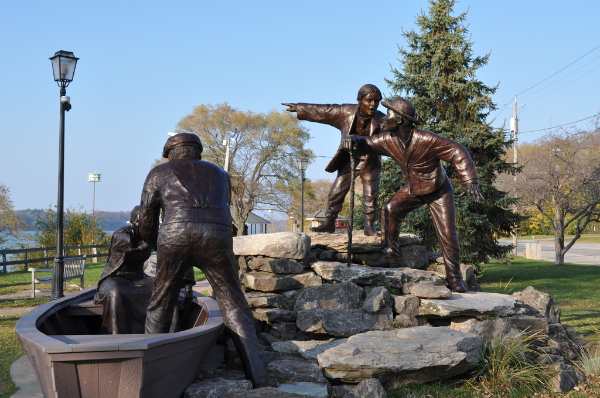In honor of Black History Month, I am pleased to feature this guest post on the Underground Railroad, a part of history that’s well worth spending time learning about.
—-
Over the years, I’ve found that introducing history to my children through travel has made more of a difference than anything they’ve read in history books. Visiting the places where history actually happened gives children and adults so much more knowledge. It also gives them a real connection to the past. As February is Black History Month, I’ve been researching Underground Railroad locations to bring history to life in our neighborhood and in preparation for our forthcoming family travels.
Here are the most interesting Underground Railroad destinations on the East Coast which are open to the public:
- Florida – Fort Gadsden State Park, Route 65, Sumatra – This abandoned fort, also known as Negro Fort, previously occupied by the British, served to hide Seminole Indians and runaway slaves until it was destroyed by the U.S. Army in 1817. Today, you can still see earthworks and trenches used to hide slaves.
- Tennessee – National Underground Railroad Museum, 115 E. Third St, Maysville – The oldest Underground Railroad Museum that houses memorabilia including runaways’ diaries and letters and slave sale broadsides. Also located in Maysville is the Harriet Beecher Stowe Slavery to Freedom Museum, 2124 Main St, Maysville – Author of Uncle Tom’s Cabin, Stowe made trips through Maysville to witness slave auctions and collected many of the artifacts now seen in the museum during these trips.
- Georgia – First African Baptist Church, 23 Montgomery St on Franklin Square, Savannah – Many churches hid slaves on the underground railroad, but not many were designed and built with that purpose in mind. The church design includes 4-feet wide underground tunnels with diamond shaped holes cut into the walls for ventilation.
- North Carolina – Coffin Home, now Guilford College Historic District, 603 W. Main St, Guilford, NC – Vestal Coffin, a Quaker farmer assisted hundreds of runaway slaves by hiding them in his farm house which is now part of Guilford College Historic District. His cousin Levi, who became known as President of the Underground Railroad, helped drive sales out of the state and eventually started his own underground railroad stop in Indiana.
- West Virginia – Harpers Ferry National Historic Park, Harpers Ferry – Harpers Ferry became famous when abolitionist John Brown seized the federal munitions arsenal there in 1859 in an attempt to help southern slaves rebel. Unfortunately, Brown was captured along with 21 other men helping him and was hanged by Colonel Robert E. Lee. Today, Harpers Ferry is a picturesque little town with a number of small buildings and a museum dedicated to the slaves. Brown’s headquarters, Kennedy Farm located in Sharpsburg MD – is also open to the public.
- Washington DC – Mt Zion United African Methodist Episcopal Church, 1334 29th St SW – Mt Zion harbored slaves, ingeniously, in an above-the-ground family burial vault in the church cemetery.
- Pennsylvania – Dobbin House, 89 Steinwehr Ave., Gettysburg – A secret room hidden between two floors and reached through pantry doors is now proudly displayed to patrons that frequent the Dobbin House. The residence now functions as a restaurant. New Jersey – D.B. Cole House, Creek Rd, Lumberton – Can be seen from the road, and rumored to be open by appointment – Cole used a well to hide runaway slaves by building a room with 20-foot ceilings at the bottom of the well. The room was reached by climbing down a long rope. As you might imagine, this secret room was never discovered!
- New York – Peterboro Area museum and Gerrit Smith Exhibit, Main St, Peterboro – Gerrit Smith, a wealthy businessman, spent his adult life fighting slavery by hiding runaways in his barn and a secret room under his kitchen. He also employed dozens of freed slaves. His biggest risk, though, was purchasing guns for John Brown to use in his attack at Harpers Ferry. Smith was never charged with a crime because he signed himself into an insane asylum and had his doctors use an insanity plea, an incredibly savvy move for the time!
- Connecticut – Old State House, 800 Main St, Hartford – The site of the first Amistad trials, the Old State House is now a museum that puts on a short, 30-minute play every Tuesday and Thursday re-enacting the trial.
As you can probably tell, I’ve ordered the Underground Railroad stops from south to north in order to imagine escaping in the night as a slave might have traveled in the 1800’s. Most of the Underground Railroad were private homes established by abolitionists that wanted to help slaves escape. Many of these homes are still standing and continue to be privately owned, so they are not likely to be open to the public. You may be able to do a walk by in your town by checking out the Underground Railroad Map.
—-
Author bio: Milan and her family of six have saved over $14,000 vacationing by home exchange over the last 5 years. Follow her on Twitter @HomeExchangeMom for tips on how to find house swaps for your family.
Photo credit: Curtis Anderson via flickr






